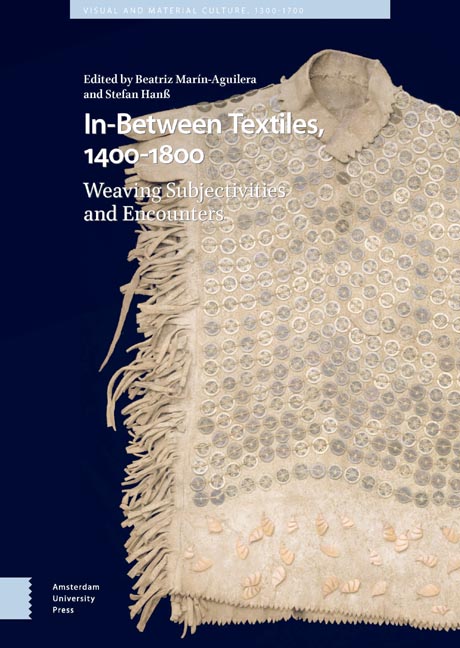Book contents
- Frontmatter
- Dedication
- Miscellaneous Frontmatter
- Table of Contents
- List of Illustrations
- Acknowledgements
- 1 Subjectivities In-Between Early Modern Global Textiles
- Part I Unhomeliness, Mimicry, and Mockery
- Part II The Material Enunciation of Difference
- Part III Identity Effects In-Between the Local and the Global
- Part IV Material Translation and Cultural Appropriation
- Archives, Libraries, and Museums (Abbreviations)
- Select Bibliography
- Index
3 - Contesting Images: The Archaeology of Early Modern Textiles, Clothing, and Closures from Puritan New England
Published online by Cambridge University Press: 14 October 2023
- Frontmatter
- Dedication
- Miscellaneous Frontmatter
- Table of Contents
- List of Illustrations
- Acknowledgements
- 1 Subjectivities In-Between Early Modern Global Textiles
- Part I Unhomeliness, Mimicry, and Mockery
- Part II The Material Enunciation of Difference
- Part III Identity Effects In-Between the Local and the Global
- Part IV Material Translation and Cultural Appropriation
- Archives, Libraries, and Museums (Abbreviations)
- Select Bibliography
- Index
Summary
Abstract
This chapter explores textile mimicry in contexts of the Massachusetts Bay Colony, highlighting the material creativity enacted in hybrid colonial settings which resulted in and got enacted through in-between textiles. At Harvard College, in Praying Towns, in Indigenous communities, and in elite merchant homes, the English and Indigenous individuals living in the Massachusetts Bay Colony negotiated Puritan laws that dictated who they were and what they wore by wearing textiles in combinations far more nuanced than images would suggest.
Keywords: textile mimicry; Indigenous agency; colonial America; Massachusetts Bay Colony; colonialism
Introduction
In 1634, the Massachusetts Bay Court put forth its first sumptuary law:
The Court, takeing into consideracon the greate, sup[er]fluous, & unneccs-sary expences occasioned by reason of some newe & immodest fashions, as also the ordinary weareing of silver, golde, & silke laces, girdles, hatbands, hath therefore ordered that no p[er]son, either man or woman, shall hereafter make or buy any apparel, either wollen, silke, or lynnen, with any lace on it, silver, golde, silke, or threed, under the penalty of forfecture of such cloathes.
For the members of this newly established colony, the message imparted in the law was clear: one’s identity as a Puritan was tied to modest dress, without excess, tied to one’s religion, status, and wealth. Modest dress according to these guidelines was intended for all members, including English and Indigenous men and women who had adopted or were forced to adopt the new religion. To dress outside of the manner dictated by the Bay Colony laws meant that one lived outside of Puritan ideologies—such as Indigenous peoples who were not converted—and outside of social order expected in the early colony where dress identified who you were. Yet colonial order rarely matches colonial reality, where people often lived in between imperial ideologies. That aspect of lived colonialism is found in the material record of the Massachusetts Bay Colony, and elsewhere in other settler colonial contexts, in the entanglement of different peoples, objects, and ideologies. Homi Bhabha reminds us of two aspects of lived colonialisms that threaten imperial order: hybridity and mimicry. Notably, hybridities of materiality, identity, ideology, and practice that diverge from imperial expectations, and semblances of mimicry that are a form of mockery and menace.
- Type
- Chapter
- Information
- In-Between Textiles, 1400-1800Weaving Subjectivities and Encounters, pp. 75 - 94Publisher: Amsterdam University PressPrint publication year: 2023



